If you can’t have fun on the new Husqvarna 701 Enduro, go ahead and take up knitting.
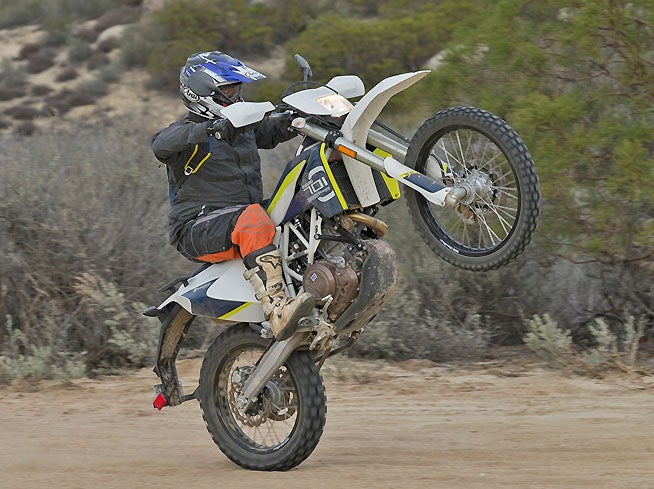
Photos By Kevin Wing
The Husqvarna revival is complete.
Since its purchase by KTM under the guise of the Pierer Group in 2014, Husqvarna has enjoyed year over year sales increases that have shattered the sales record set in its heydays during the 1970s and 1980s. The 2014 model year saw Husky sell 16,000 units sold globally, and that figure swelled to 20,500 units in 2015, with the U.S. market responsible for 27% of those sales.
That’s better than the brand has ever done, but that’s because Husqvarna is in better hands than it has been since it was Swedish-controlled. With KTM’s engineering acumen guiding the product, and with a small but dedicated and enthuiastic staff pushing the brand in North America, it isn’t inconceivable that Husqvarna could give more than one Japanese brand a run for its money in the off-road segment.
Skeptical? Then swing a leg over Husqvarna’s all-new 701 Enduro, and if this new thumper can’t put a smile on your face, see a doctor.
The 701 Enduro owes its existence to the KTM 690 Enduro R, but the Husky is more than just a KTM wearing white, yellow and blue. There are areas where the two machines differ, and some of those differences, such as the 701 Enduro’s use of WP’s 4CS closed-cartridge fork, actually favor the Husqvarna.
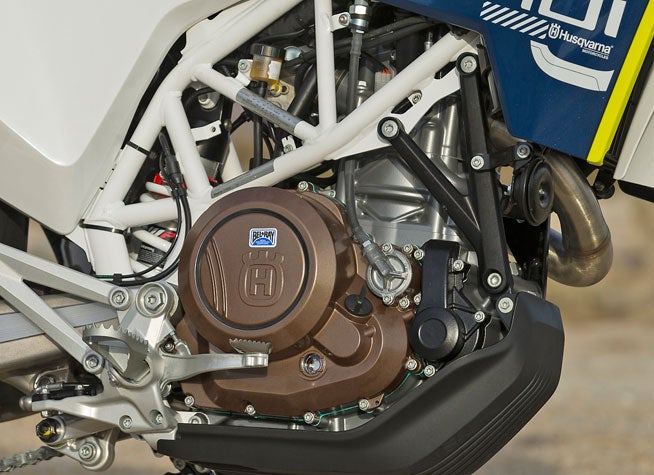
The engine, however, is the same Austrian-built 690cc SOHC four-valve Single, delivering potent yet user-friendly power. With its large, 102mm bore, short 84mm stroke and 12.6:1 compression ratio, the 701 doesn’t need to rely on stratospheric rpm to make power like a 450cc motocross bike does. In fact, Husqvarna claims that the 701 produces its maximum of 67 crankshaft horsepower at just 7000 rpm while its 49 lb.-ft. of peak torque occurs at 6500 rpm.
Breathing is handled via a closed-loop Keihin fuel-injection system with a 46mm throttle body that takes air from a front-mounted airbox under the seat. The fuel/air mixture enters the combustion chamber via a pair of 40mm intake valves, while spent gases exit through 34mm valves. Ignition chores are handled by a Keihin Engine Management System (EMS) that features a twin spark plug layout with independent ignition curves for each plug. Husqvarna says that the ignition system not only allows the fuel charge to burn more completely for better power production and greater fuel efficiency, but it also helps to smooth the power delivery. Like the KTM, the Husqvarna also offers the rider a choice of three power modes, Soft, Standard or Advanced, to tailor the power output to rider preference or riding conditions. The mode can be changed via a small rotary dial located under the seat.
We sure couldn’t have asked for a better day or a better location for our introduction to the 701 Enduro, as Husqvarna graciously invited us on a two-day ride that included one day of scouring the serpentine two-lane roads that lead from Husqvarna’s Temecula, California, down to Borrego Springs in the Anza-Borrego Desert aboard the 701 Enduro’s twin sister, the 2016 Husqvarna 701 Supermoto. Day two was then spent gloriously grinding out 130 miles on a different course back to Temecula. With over 70% of the route taking place in the desert, our test group had great fun whooping it up in Anza Borrego’s sand washes, fire roads and twisty two-track trails.
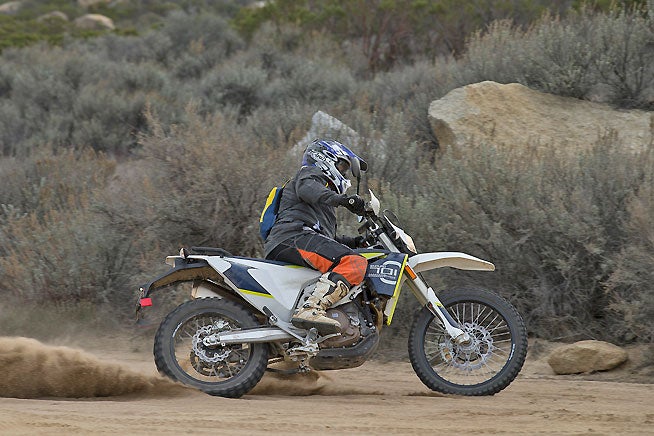
Hop aboard the 701 Enduro, thumb the electric starter, and the engine burbles to life with ease. That’s partially because the engine features an automatic decompression system on the camshaft that allows the starter to spin the engine over more freely and partially because the fuel-injection mapping appears to be dialed-in perfectly. The latter is something you notice no matter how aggressively you roll on the throttle, but there’s something else at play here as well: The 701 features a ride-by-wire throttle system that delivers a light and a linear feel regardless of throttle position. As you twist the throttle, the throttle valve is electronically controlled by the EMS, which continuously compares engine parameters with data from various sensors and adjusts the throttle valve as necessary to deliver the right amount of power. There’s zero lag, so the 701’s throttle response is crisp. At the same time its large volume muffler tones the thump from that big 102mm, forged, box-type piston, keeping the exhaust note at a respectable volume regardless of how hard you get on the gas. For the sake of comparison, the 701 sounds more like a Honda XR400 than a Husqvarna FC 450 motocrosser, and that’s a good thing since treading lightly has never been more critical to keeping our public riding lands open.
But you won’t confuse quiet for a lack of power. Click the 701 Enduro’s six-speed transmission into gear, and engage its slipper-style Adler Power Torque Clutch (APTC) to get rolling, and that’s about the last time you may need to use it while the Husky is in motion. The 701’s engine may be relatively new, but it churns out old-school four-stroke power. A tasty dollop of low-end torque makes it easy loft the front end, the 701’s broad, flat torque curve keeps it pulling throughout the rev range. There’s never any need to flick its light and smooth hydraulically assisted clutch lever except to occasionally control wheel spin when the going gets slick or rocky. In most cases, you can just pick a gear and lug your way up and over any hill or through any rough technical section. Power delivery is seamless, and the 701 is good at maintaining forward momentum in a taller gear than you might think. The engine will always seems to take up the slack if you should need a sudden burst of power even with its tallish stock 15/45 final gearing. This may be one of the most tractable engines ever devised for dual-sport use.
It was the same story on the highway stretches we encountered when linking our dirt sections. The 701’s gear ratios are nicely spaced for long-distance road work. She’ll break the ton without breaking a sweat, something we had to be wary of as we encountered our fair share of local law enforcement, some of whom duly warned us that “in response to calls from local residents,” (yeah, sure) we needed to watch our speed.
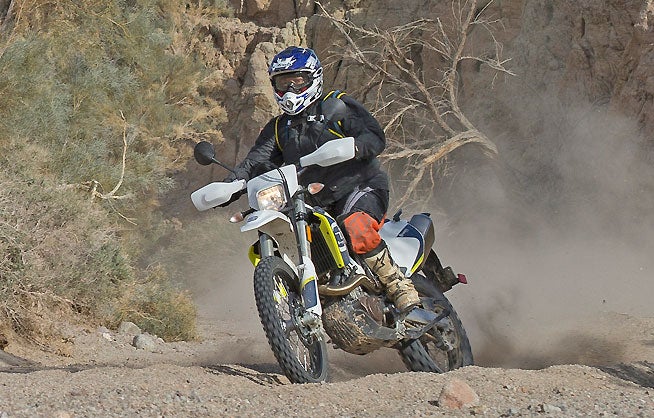
But speed is an easy thing to manage when you’re aboard a motorcycle with a sure-footed chassis, and the Husqvarna’s is about as confidence-inspiring as any dual-sporter we’ve ever ridden. We’re suckers for chrome-moly trellis frames, which typically offer excellent rigidity without compromising road feel. Produced by KTM subsidiary WP, the 701’s lovely laser-cut/hydroformed and robot-welded “birdcage” weighs a scant 18.5 lbs. bare, and it’s mated to a Husqvarna trademark Polyamide subframe that also serves as the 701 Enduro’s 3.4-gallon fuel cell. The curvaceous unit only weighs another 11.5 lbs. empty. A lightweight, one-piece die-cast aluminum swingarm completes a superstructure that delivers excellent straight line stability, even over choppy terrain. In deep sand, the 701 Enduro refuses to twitch or shake. The Husky’s chassis is well-balanced, and its center of gravity feels very low, which only adds to rider confidence. Full speed ahead!
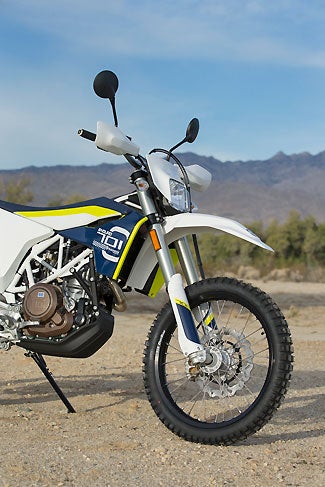
We also had no complaints about the 701 Enduro’s suspension, which includes the same version of WP’s 48mm 4CS closed-cartridge fork that is found on the KTM 450 SX motocross bike albeit with different specs. The four-chamber spring fork’s design splits the damping circuits between its two legs, with the compression damping in the left leg and the rebound damping in the right. We dialed-in the quality of the fork’s 10.8” of travel simply by backing off a couple clicks of compression from the stock setting and found perfect harmony in the dirt as well as on the road. The 4CS is a very competent fork, offering a taut feel that isn’t unduly harsh, and it can soak up hits from rain ruts and the occasional rock without deflecting or punishing the rider through the bars.
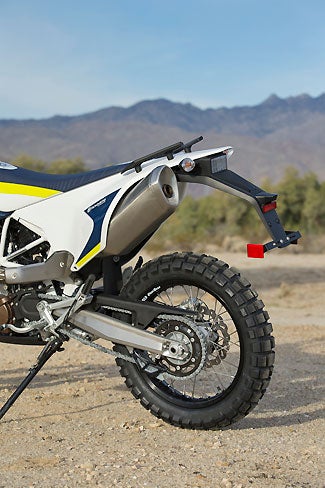
The same can be said for the 701’s ergos. First of all, Husqvarna engineers worked hard to eliminate as much vibration from the package as possible, and they largely accomplished this by fitting the engine with a large, gear-driven counterbalancer, any vibration that might still make its way to the handlebars is quelled by rubber-mounted bar clamps. The net result is a single-cylinder motorcycle that is almost as smooth feeling as a triple, even when you are revving it out in a lower gear, which is really unnecessary because of the engine’s broad torque curve. The package is so smooth that we didn’t notice any vibration through the footpegs either.
The 701 boasts a roomy cockpit, with a wide and flat handlebar, nicely tucked-in radiator shrouds and a seat that is slim near the front to allow the rider to get forward for cornering and wider at the rear to offer a little better dispersion of the rider’s weight. The seat material itself isn’t the softest we’ve ever encountered, but 120-miles in the saddle prove to be no trouble at all.
A few words about the 701 Enduro’s Brembo brakes—loved ‘em, even better than the brakes on the 701 Supermoto. A massive-looking 300mm floating wave rotor and Brembo two-piston caliper can be found up front, while a 240mm floating wave rotor and Brembo single-piston caliper are located out back, and the 701 Enduro benefits from a Bosch 9M two-channel ABS that can be deactivated if the rider so chooses. Our test unit came equipped with a Husqvarna catalog accessory dongle that allowed the front ABS to remain activated while the rear ABS was deactivated. We could actually feel the front ABS at work in some of the more slippery dirt sections, and we appreciated the extra peace of mind it gave us. Braking performance was smooth and predictable without being grabby, something that cannot be said for the road-race style Monobloc front caliper found on the 701 Supermoto.
We also dig the choice Husqvarna made when it comes to tire fitment. We’ve long been fans of Continental’s TKC-80 dual-sport tires, and the 90/90-21 front and 140/80-18 rear didn’t disappoint. Grip and feel are excellent on the road or in the dirt. In fact, not having been on them in a while, we were pleasantly surprised—again—by their off-road performance when you consider that we never aired down for the dirt sections on our route. There was still just enough sidewall flex in the Contis to maintain decent grip in all but the most dry-slick portions of the trail. And again, thanks to the slow-revving and predictable nature of the 701’s power delivery, we never found ourselves suddenly engaged in an impromptu break dance due to an unexpected loss of traction.
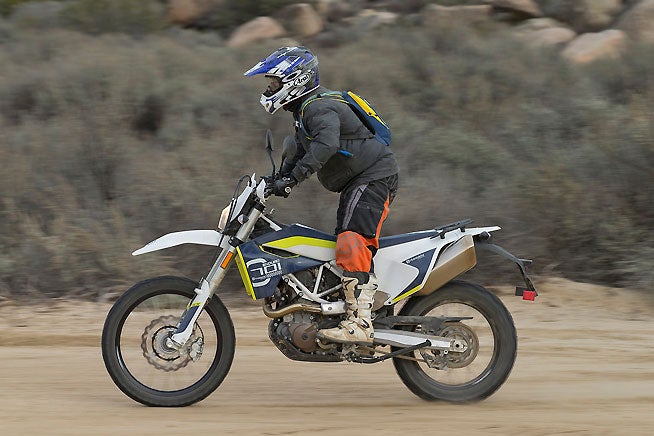
We know, the 701 Enduro sounds too good to be true, but there are some hitches in the Husky’s giddyup, starting with the transmission. Sure, we like the fact that the brawny engine allows us to ride a gear tall in most situations, but what we don’t like is having to row through the transmission, which isn’t the smoothest-shifting gearbox we’ve ever encountered. It’s definitely not the most precise, especially when you try to shift under a partial throttle load. We missed shifts on several occasions, and on three different test bikes, which was enough to lead us to believe that it isn’t just an isolated incident. The one-two and five-six upshifts are particularly balky, and finding neutral isn’t an easy thing to do when the engine is running. This is one area where the 701 could use more refinement.
Another thing, while we were perfectly happy to stick with the Advanced power mode on our ride, we don’t understand why, four years along now, KTM (and now Husqvarna) has not made the power mode feature switchable via a button mounted on the handlebar or the instrument display. Cheesy.
We also don’t particularly care for the front numberplate/headlight design. There is nothing wrong with the performance of the headlight itself, but during our breezy early morning rides we noticed that the unit diverts air straight into the rider’s chest. We’ve tested a lot of dual-sport machines with the same basic nose configuration, and most of them have offered at least some wind protection. Not the Husqvarna. Husky officials appear to be well aware of this, however, as they showed us a drawing for a forthcoming accessory windscreen. If we lived in wetter or colder climates, it would be a must-have item.
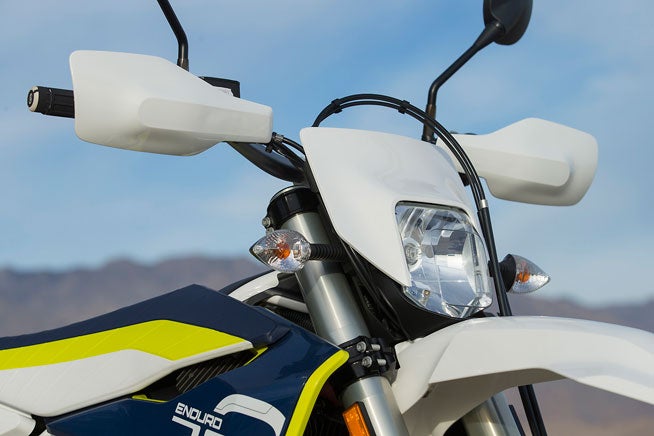
But even with the transmission gripe, you’d have to go a long way to find a more sorted first-year dual-sport machine than the Husqvarna 701 Enduro. It delivers the perfect combination of power, handling and suspension on or off the trail. It looks great, and its engine performance alone is worth the $11,299 asking price. Husqvarna is taking orders for the 701s as we speak. If you’ll excuse us, we need to go get in line.
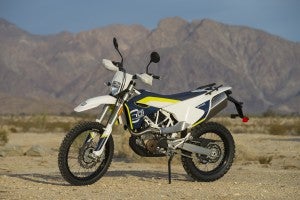 2016 Husqvarna 701 Enduro Specifications
2016 Husqvarna 701 Enduro Specifications
MSRP: $11,249
Engine Type: 690cc liquid-cooled, SOHC, four-valve, four-stroke Single
Claimed HP: 67 hp (crankshaft) @ 7000 rpm
Claimed Peak Torque: 49.5 lb.-ft. @ 6500 rpm
Bore and Stroke: 102 x 84.5mm
Compression Ratio: 12.6:1
Fuel Delivery: Keihin EFI, 46mm throttle body
Ignition: Keihin EMS w/ride-by-wire throttle, selectable ignition mapping
Transmission: Constant mesh, 6-speed, w/hydraulically actuated APTC (Adler Power Torque Control) slipper clutch
Final Drive: Chain
Final Gearing: 15/45
Front Suspension: 48mm WP 4CS cartridge fork; compression and rebound adjustable, 10.8-in. travel
Rear Suspension: WP single shock; compression and rebound adjustable, 10.8-in. travel
Front Brake: 300mm floating wave rotor w/Brembo two-piston caliper
Rear Brake: 240mm floating wave rotor w/Brembo single-piston caliper
ABS: Bosch 9M two-channel ABS
Front Tire: 90/90-21 Continental TKC-80
Rear Tire: 140/80-18 Continental TKC-80
Chassis: Chrome-moly trellis mainframe w/Polyamide subframe/fuel tank
Steering Head Angle: 27°
Triple Clamp Offset: 32mm (1.26 in.)
Trail: 1504mm (4.4 in.)
Wheelbase: 59.2 in.
Seat Height: 35.8 in.
Ground Clearance: 11.0 in.
Fuel Capacity: 3.4 gal.
Color: White/Blue/Yellow
Claimed Wet Weight*: 319.0 lbs.
* Weight includes the vehicle with empty fuel tank but with standard equipment and all fluids, including oil and coolant (as applicable).
 Your Privacy Choices
Your Privacy Choices